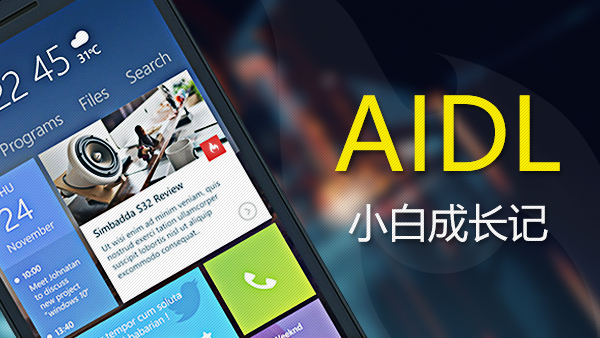AIDL是什么
AIDL英文全称Android Interface Definition Language,中文Android接口定义语言,在Android中,
AIDL定义了程序访问接口,并将对象进行序列化,通过该接口,使得进程间采用IPC(进程间通信机制,比如binder)
进行交互、传输数据。
AIDL应用场合
a. 在不同应用程序之间,如果客户端需要访问服务端,并且想要处理多线程任务时,采用AIDL;
b. 如果不需要进行跨进程通信,就可以不使用AIDL,比如绑定本地服务,只需继承binder,在
onBind中返回一个binder对象即可;
c. 如果要跨进程通信,但又不需要多线程操作,就使用Messenger方式,实际上Messenger也是基于AIDL的,
只是把AIDL作为底层使用了。Messenger方式中所有的消息存放在一个队列中,每次只允许一个消息待处理。
如果想让服务能够处理多个请求,就使用AIDL。
AIDL和bindservice(又称为bound services)之间的关系
bindservice一般分为两种情况:绑定本地服务;绑定远程服务。
本地服务就是同一个进程中即同一个应用程序中,绑定远程服务指不同进程中,即不同应用程序中。
AIDL一般用在绑定远程服务中,因为这涉及到跨进程操作,需要通过AIDL定义统一接口,传输序列化数据。
注意:大部分应用程序不应该用AIDL来创建bindservice服务,因为多线程处理,让代码变得复杂,不易维护,特殊情况下才使用AIDL。(参考Android官方文档)
创建AIDL服务分为三步:
创建.aidl文件
实现aidl接口
客户端获取接口
为了更加清晰地描述这个过程,本文给出一个实例辅助分析。
案例
定义一个aidl接口displayInformation,用来显示个人的姓名和年龄信息
左边是服务端,右边是客户端,对比红色方框内的内容,aidl包中的文件结构都是一样的。
案例源码下载地址:http://yunpan.cn/cLippY2ib7RHH 访问密码 9ebb
a. 创建接口(创建aidl文件)
创建服务端IPersonInformation.aidl文件,包含一个displayInformation方法,显示个人的姓名和年龄
1 2 3 4 5 6 7 | package com.example.person.aidl; import com.example.person.aidl.Person;
interface IPersonInformation { String displayInformation(in Person requester); } |
接口前面不能加访问权限修饰符public、private等。因为displayInformation传递的参数是对象,属于非基本数据类型,需要加上in、out、inout修饰符,其含义是:
如果在客户端输入本地数据,服务端接受数据,就用in修饰符;
如果在客户端接收数据,服务端把本地修改后的数据向客户端传输,就用out修饰符;
如果同时满足in和out,就用inout修饰。
本文中定义的接口displayInformation从客户端接收数据,在服务端组合后返回给客户端,客户端相当于输入,服务端是输出,用in修饰符,即:
1 | String displayInformation(in Person requester); |
除了原始基本数据类型(int, long, char, boolean等)、String 、CharSequence以及包含基本数据类型的list和map外,都需要用import语句把对象引用过来,因为person是对象类型,因此用import引入。
一般情况下,Android中远程接口类型名称都用大写的I开头加上接口的名字,这并不是硬性要求,但为了维护程序风格,这样写可读性较高。因为aidl接口都实现IInterface,字母前缀I的含义是IInterface类,表示这是一个可以提供远程服务的类。
b. 实现接口
1 2 3 4 5 6 7 8 9 10 11 12 13 14 15 16 17 18 19 20 21 22 23 24 25 26 27 28 29 30 31 32 33 34 35 36 37 38 39 40 41 42 43 44 45 46 47 48 49 50 51 52 53 54 55 56 57 58 59 60 61 62 63 64 65 66 67 68 69 70 | package com.example.person.service;
// This file is StockQuoteService2.java
import com.example.person.R; import android.app.Notification; import android.app.NotificationManager; import android.app.PendingIntent; import android.app.Service; import android.content.Intent; import android.os.IBinder; import android.os.RemoteException;
import com.example.person.activity.TestActivity; import com.example.person.aidl.Person; import com.example.person.aidl.IPersonInformation;
public class PersonInformationService extends Service { private NotificationManager notificationMgr;
public class IPersonInformationImpl extends IPersonInformation.Stub { public String displayInformation(Person person) throws RemoteException { return "Hello " + person.getName() + "! Your age is: " + person.getAge(); } }
@Override public void onCreate() { super.onCreate();
notificationMgr = (NotificationManager) getSystemService(NOTIFICATION_SERVICE);
displayNotificationMessage("onCreate() called in StockQuoteService2"); }
@Override public void onDestroy() { displayNotificationMessage("onDestroy() called in StockQuoteService2"); // Clear all notifications from this service notificationMgr.cancelAll(); super.onDestroy(); }
public int onStartCommand(Intent intent, int flags, int startId) { return super.onStartCommand(intent, flags, startId); }
@Override public IBinder onBind(Intent intent) { displayNotificationMessage("onBind() called in StockQuoteService2"); return new IPersonInformationImpl(); }
private void displayNotificationMessage(String message) { Notification notification = new Notification(R.drawable.emo_im_happy, message, System.currentTimeMillis());
PendingIntent contentIntent = PendingIntent.getActivity(this, 0, new Intent(this, TestActivity.class), 0);
notification.setLatestEventInfo(this, "StockQuoteService2", message, contentIntent);
notification.flags = Notification.FLAG_NO_CLEAR;
notificationMgr.notify(R.id.app_notification_id, notification); } } |
主要实现核心代如下:
1 2 3 4 5 6 7 | public class IPersonInformationImpl extends IPersonInformation.Stub { public String displayInformation(Person person) throws RemoteException { return "Hello " + person.getName() + "! Your age is: " + person.getAge(); } } |
实现类名为IPersonInformationImpl,继承了IPersonInformation.Stub,IPersonInformation.Stub是一个binder接口,如果在eclipse中建立好aidl文件后,编译时会自动生成与aidl同名的java文件IPersonInformation.java,displayInformation为实现的方法。注意,该接口需要Person类,因此还必须把perons类接口文件import进来才能自动生成IPersonInformation.java,下文会提到Person类。
因为传输的对象为Person,非基本数据类型,需要对其序列化,Android中用Parcelable接口来实现,之所以用Parcelable接口,是因为更快、性能更好,Android中进程间通信中大量使用Parcelable接口。
1 2 3 4 5 6 7 8 9 10 11 12 13 14 15 16 17 18 19 20 21 22 23 24 25 26 27 28 29 30 31 32 33 34 35 36 37 38 39 40 41 42 43 44 45 46 47 48 49 50 51 52 53 54 55 56 57 58 59 60 | package com.example.person.aidl;
import android.os.Parcel; import android.os.Parcelable;
public class Person implements Parcelable {
private int age; private String name; public static final Parcelable.Creator<Person> CREATOR = new Parcelable.Creator<Person>() { public Person createFromParcel(Parcel in) { return new Person(in); }
public Person[] newArray(int size) { return new Person[size]; } }; public Person() { }
private Person(Parcel in) { readFromParcel(in); }
@Override public int describeContents() { // TODO Auto-generated method stub return 0; }
@Override public void writeToParcel(Parcel out, int flags) { // TODO Auto-generated method stub out.writeInt(age); out.writeString(name); }
public void readFromParcel(Parcel in) { age = in.readInt(); name = in.readString(); }
public int getAge() { return age; }
public void setAge(int age) { this.age = age; }
public String getName() { return name; }
public void setName(String name) { this.name = name; } } |
Parcelable接口必须实现三个方法:
Parcelable.Creator // 用来产生Person对象
describeContents // 返回特殊对象类型,一般返回0
writeToParcel // 把数据写入到Parcel对象中,Parcel中文含义为包裹,形象地表明先把数据包装好,等待传输,在接收方接收后再解压包裹从中得到数据,起到安全性作用。
IPersonInformation.aidl在编译时需要用到待序列化对象Person,因此还需要创建Person.aidl文件,Person类没有具体方法,代码相对简单:
1 2 | package com.example.person.aidl; parcelable Person; |
Person类前加parcelable修饰符,表示这是一个待序列化对象。
在eclipse中编译会自动生成IPersonInformation.java,位于gen目录下,这样服务端文件创建成功。
c. 获取接口
客户端要获取服务端接口,先把aidl目录整体拷贝到客户端,
包名com.example.person.aidl也要一致,这个报名和AndroidManifest的包名不是一回事,前者就是文件目录,后者是APP的包名。
创建PersonClientActivity,继承于Activity:
1 2 3 4 5 6 7 8 9 10 11 12 13 14 15 16 17 18 19 20 21 22 23 24 25 26 27 28 29 30 31 32 33 34 35 36 37 38 39 40 41 42 43 44 45 46 47 48 49 50 51 52 53 54 55 56 57 58 59 60 61 62 63 64 65 66 67 68 69 70 71 72 73 74 75 76 77 78 79 80 81 82 83 84 85 86 87 88 89 90 91 92 93 94 95 96 97 98 99 100 101 102 | package com.example.personclient.activity;
import com.example.person.aidl.Person; import com.example.personclient.R; import com.example.person.aidl.IPersonInformation;
import android.app.Activity; import android.content.ComponentName; import android.content.Context; import android.content.Intent; import android.content.ServiceConnection; import android.os.Bundle; import android.os.IBinder; import android.os.RemoteException; import android.util.Log; import android.view.View; import android.view.View.OnClickListener; import android.widget.Button; import android.widget.Toast;
public class PersonClientActivity extends Activity {
protected static final String TAG = "StockQuoteClient2"; private IPersonInformation iPersonInformation = null;
private Button bindBtn; private Button callBtn; private Button unbindBtn;
private ServiceConnection serviceConnection = new ServiceConnection() {
@Override public void onServiceConnected(ComponentName name, IBinder service) { Log.v(TAG, "---------------service: " + service.getClass().toString()); iPersonInformation = IPersonInformation.Stub.asInterface(service); Log.v(TAG, "---------------stockService: " + iPersonInformation.getClass().toString()); callService(); }
@Override public void onServiceDisconnected(ComponentName name) { iPersonInformation = null; } };
/** Called when the activity is first created. */ @Override public void onCreate(Bundle savedInstanceState) { super.onCreate(savedInstanceState); setContentView(R.layout.main);
bindBtn = (Button) findViewById(R.id.bindBtn); bindBtn.setOnClickListener(buttonClickListener);
callBtn = (Button) findViewById(R.id.callBtn); callBtn.setOnClickListener(buttonClickListener); callBtn.setEnabled(false);
unbindBtn = (Button) findViewById(R.id.unbindBtn); unbindBtn.setOnClickListener(buttonClickListener); unbindBtn.setEnabled(false);
}
OnClickListener buttonClickListener = new OnClickListener() {
@Override public void onClick(View v) { // TODO Auto-generated method stub if (v.getId() == R.id.bindBtn) { bindService(new Intent("com.example.person.PersonInformationService"), serviceConnection, Context.BIND_AUTO_CREATE); bindBtn.setEnabled(false); callBtn.setEnabled(true); unbindBtn.setEnabled(true); } else if (v.getId() == R.id.callBtn) { callService(); } else if (v.getId() == R.id.unbindBtn) { unbindService(serviceConnection); bindBtn.setEnabled(true); callBtn.setEnabled(false); unbindBtn.setEnabled(false); } }
};
private void callService() { try { Person person = new Person(); person.setAge(32); person.setName("zhulf"); String response = iPersonInformation.displayInformation(person); Toast.makeText(PersonClientActivity.this, "Value get from service is: " + response, Toast.LENGTH_SHORT).show(); } catch (RemoteException ee) { Log.e("MainActivity", ee.getMessage(), ee); } }
} |
核心代码为:
1 2 3 4 5 6 7 8 9 10 11 12 13 14 15 | private ServiceConnection serviceConnection = new ServiceConnection() {
@Override public void onServiceConnected(ComponentName name, IBinder service) { Log.v(TAG, "---------------service: " + service.getClass().toString()); iPersonInformation = IPersonInformation.Stub.asInterface(service); Log.v(TAG, "---------------stockService: " + iPersonInformation.getClass().toString()); callService(); }
@Override public void onServiceDisconnected(ComponentName name) { iPersonInformation = null; } }; |
1 2 | bindService(new Intent("com.example.person.PersonInformationService"), serviceConnection, Context.BIND_AUTO_CREATE); |
单击绑定按钮时调用binderservice把serviceConnection与PersonInformationService服务端绑定,当bindservice绑定成功后,系统会调用onServiceConnected方法,第二个参数service是一个IBinder接口对象,由服务端onBind方法返回给客户端的,IPersonInformation.Stub的asInterface返回一个客户端代理对象proxy,赋值给IPersonInformation对象,这样,客户端就获得了服务端接口。
d. 使用服务
既然客户端已经获得了服务端的接口对象,那么就可以调用服务端的方法来得到服务。
1 2 3 4 | Person person = new Person(); person.setAge(32); person.setName("zhulf"); String response = iPersonInformation.displayInformation(person); |
先设置person的内容,而后采用服务端对象iPersonInformation调用服务端的方法displayInformation来获得所需要的数据,这可以形象地描述成客户端得到了服务端的服务!
把生成的服务端、客户端apk安装后,打开客户端,如图3所示,点击bind按钮后显示如图4,客户端设置了姓名”jack”,年龄”100″已经通过远程服务接口displayInformation显示出来了。
点击CALL AGAIN按钮后重复显示toast,点击UNBIND按钮后停止服务。
AIDL服务的详细执行过程
a. PersonInformationService启动过程
bindService通过Intent的action——”com.example.person.PersonInformationService”启动PersonInformationService服务,服务启动成功后由onBind返回一个IPersonInformationImpl对象,IPersonInformationImpl继承了IPersonInformation.Stub,IPersonInformation.Stub又继承了Binder,Binder实现了IBinder接口,因此,onBind返回的是一个IBinder接口对象,通过添加Logcat打印发现实际返回的是一个BinderProxy对象,这是什么原因?
这是binder进程间通信机制所决定的,服务启动后,系统会生成一个binder代理对象binderProxy,用作桥梁,与C++层的BpBinder对应,在aidl服务中通过binderProxy生成prox客户端代理对象。
b. 客户端获取代理接口
上文提到binderProxy用来生成proxy对象,如何生成?上文提到aidl文件在编译时会自动生成java文件,即IPersonInformation.java,源码:
1 2 3 4 5 6 7 8 9 10 11 12 13 14 15 16 17 18 19 20 21 22 23 24 25 26 27 28 29 30 31 32 33 34 35 36 37 38 39 40 41 42 43 44 45 46 47 48 49 50 51 52 53 54 55 56 57 58 59 60 61 62 63 64 65 66 67 68 69 70 71 72 73 74 75 76 77 78 79 80 81 82 83 84 85 86 87 88 89 90 91 92 93 94 95 96 97 98 99 100 101 102 103 104 105 106 107 108 109 | /* * This file is auto-generated. DO NOT MODIFY. * Original file: E:\\demos_from_internet\\PersonInformationClient\\PersonInformationClient\\src\\com\\example\\person\\aidl\\IPersonInformation.aidl */ package com.example.person.aidl;
public interface IPersonInformation extends android.os.IInterface { /** Local-side IPC implementation stub class. */ public static abstract class Stub extends android.os.Binder implements com.example.person.aidl.IPersonInformation { private static final java.lang.String DESCRIPTOR = "com.example.person.aidl.IPersonInformation";
/** Construct the stub at attach it to the interface. */ public Stub() { this.attachInterface(this, DESCRIPTOR); }
/** * Cast an IBinder object into an * com.example.person.aidl.IPersonInformation interface, generating a * proxy if needed. */ public static com.example.person.aidl.IPersonInformation asInterface(android.os.IBinder obj) { if ((obj == null)) { return null; } android.os.IInterface iin = obj.queryLocalInterface(DESCRIPTOR); if (((iin != null) && (iin instanceof com.example.person.aidl.IPersonInformation))) { return ((com.example.person.aidl.IPersonInformation) iin); } return new com.example.person.aidl.IPersonInformation.Stub.Proxy(obj); }
@Override public android.os.IBinder asBinder() { return this; }
@Override public boolean onTransact(int code, android.os.Parcel data, android.os.Parcel reply, int flags) throws android.os.RemoteException { switch (code) { case INTERFACE_TRANSACTION: { reply.writeString(DESCRIPTOR); return true; } case TRANSACTION_displayInformation: { data.enforceInterface(DESCRIPTOR); com.example.person.aidl.Person _arg0; if ((0 != data.readInt())) { _arg0 = com.example.person.aidl.Person.CREATOR.createFromParcel(data); } else { _arg0 = null; } java.lang.String _result = this.displayInformation(_arg0); reply.writeNoException(); reply.writeString(_result); return true; } } return super.onTransact(code, data, reply, flags); }
private static class Proxy implements com.example.person.aidl.IPersonInformation { private android.os.IBinder mRemote;
Proxy(android.os.IBinder remote) { mRemote = remote; }
@Override public android.os.IBinder asBinder() { return mRemote; }
public java.lang.String getInterfaceDescriptor() { return DESCRIPTOR; }
@Override public java.lang.String displayInformation(com.example.person.aidl.Person requester) throws android.os.RemoteException { android.os.Parcel _data = android.os.Parcel.obtain(); android.os.Parcel _reply = android.os.Parcel.obtain(); java.lang.String _result; try { _data.writeInterfaceToken(DESCRIPTOR); if ((requester != null)) { _data.writeInt(1); requester.writeToParcel(_data, 0); } else { _data.writeInt(0); } mRemote.transact(Stub.TRANSACTION_displayInformation, _data, _reply, 0); _reply.readException(); _result = _reply.readString(); } finally { _reply.recycle(); _data.recycle(); } return _result; } }
static final int TRANSACTION_displayInformation = (android.os.IBinder.FIRST_CALL_TRANSACTION + 0); }
public java.lang.String displayInformation(com.example.person.aidl.Person requester) throws android.os.RemoteException; } |
该文件自动生成后,系统分别创建两个对象:服务端Stub、客户端Proxy。服务端、客户端分别都由这两个对象代理操作,那客户端Proxy如何获得?这就是asInterface方法的作用。
1 | iPersonInformation = IPersonInformation.Stub.asInterface(service); |
1 2 3 4 5 6 7 8 9 10 | public static com.example.person.aidl.IPersonInformation asInterface(android.os.IBinder obj) { if ((obj == null)) { return null; } android.os.IInterface iin = obj.queryLocalInterface(DESCRIPTOR); if (((iin != null) && (iin instanceof com.example.person.aidl.IPersonInformation))) { return ((com.example.person.aidl.IPersonInformation) iin); } return new com.example.person.aidl.IPersonInformation.Stub.Proxy(obj); } |
queryLocalInterface返回IInterface接口对象,再判断该对象实际类型是不是IPersonInformation类型,如果是就返回该对象,否则就new一个Proxy对象。参数obj是一个binderProxy对象,其queryLocalInterface方法源码为:
1 2 3 | public IInterface queryLocalInterface(String descriptor) { return null; } |
该方法什么都没做,直接返回空值,那么iin为空,跳过了下面的if语句:
1 2 3 | if (((iin != null) && (iin instanceof com.example.person.aidl.IPersonInformation))) { return ((com.example.person.aidl.IPersonInformation) iin); } |
继续执行:
1 | return new com.example.person.aidl.IPersonInformation.Stub.Proxy(obj); |
创建一个包含binderProxy对象的Proxy对象。
asInterface方法的主要作用:如果是多进程操作,参数obj是binderProxy对象,就new一个proxy接口;如果是当前进程操作,obj是本地binder对象,就返回本地binder对象,这种情况不存在多进程通信。
Proxy类构造方法为:
1 2 3 | Proxy(android.os.IBinder remote) { mRemote = remote; } |
把binderProxy对象保存到mRemote变量,mRemote在aidl中是一个辅助变量。
这样就获得了客户端代理接口proxy。
c. 通过代理接口获得服务
标题叫“通过代理接口获得服务”,意思是proxy调用displayInformation方法获得结果的过程,当系统执行到:
1 | String response = iPersonInformation.displayInformation(person); |
iPersonInformation变量保存了proxy对象,displayInformation方法的“中间实现”情况为:
[代码]java代码:
01 02 03 04 05 06 07 08 09 10 11 12 13 14 15 16 17 18 19 20 21 22 23 |
|
之所以叫中间实现,是因为displayInformation的最终实现代码在IPersonInformationImpl中,此处只是中间状态。静态方法obtain从Parcel池中获得一个Parcel对象分别保存到_data、_reply中,_data、_reply分别是发送数据和接受数据时的承载器、包裹。writeInterfaceToken写入一个字符串标记,writeInt写入一个标志位,writeToParcel把Person对象中的数据写入到parcel中,然后执行:
1 | mRemote.transact(Stub.TRANSACTION_displayInformation, _data, _reply, 0); |
客户端对象mRemote(就是binderProxy)调用transact方法向服务端发送请求,第一个参数就是请求命令号,服务端根据这个命令号找到相应的执行方法。
transact方法进入到C++层,交由BpBinder处理,最终经过binder驱动处理后,转交给binder服务端,服务端层层调用到java层,由java层的服务端对象stub的onTransact方法处理:
1 2 3 4 5 6 7 8 9 10 11 12 13 14 15 16 17 18 19 20 21 22 23 24 | @Override public boolean onTransact(int code, android.os.Parcel data, android.os.Parcel reply, int flags) throws android.os.RemoteException { switch (code) { case INTERFACE_TRANSACTION: { reply.writeString(DESCRIPTOR); return true; } case TRANSACTION_displayInformation: { data.enforceInterface(DESCRIPTOR); com.example.person.aidl.Person _arg0; if ((0 != data.readInt())) { _arg0 = com.example.person.aidl.Person.CREATOR.createFromParcel(data); } else { _arg0 = null; } java.lang.String _result = this.displayInformation(_arg0); reply.writeNoException(); reply.writeString(_result); return true; } } return super.onTransact(code, data, reply, flags); } |
根据客户端发送请求的命令号TRANSACTION_displayInformation找到case子句,首先由enforceInterface方法读出客户端写入的字符串,验证是否正确。readInt读出标志位,如果是1,就重新组建序列化的Person对象保存到_arg0中。
1 | java.lang.String _result = this.displayInformation(_arg0); |
this表示当前正在运行的的对象,就是stub对象,在服务端IPersonInformationImpl实现了stub,因此,this就是IPersonInformationImpl对象,进程执行到了:
1 2 3 | public String displayInformation(Person person) throws RemoteException { return "Hello " + person.getName() + "! Your age is: " + person.getAge(); } |
这个方法就是返回一段字符串,保存到_result变量中。
1 | reply.writeString(_result); |
writeString方法把结果存到parcel对象中,再次通过进程间通信机制,穿过Binder驱动,C++层,返回到客户端的transact中,客户端从返回的parcel对象中读出返回值,最终返回到PersonClientActivity的这句话:
1 | String response = iPersonInformation.displayInformation(person); |
就是把结果保存到response里面。
这就完成了客户端、服务端进程全部通信过程,
途中双向箭头表示数据双向传输,发送到服务端后,服务端把处理后的数据又返回给客户端。
aild可以说是应用层为了实现两个不同应用程序通信来设计的,用户设计统一的接口方法,然后由系统自动生成java文件,并提供了服务端和客户端代理,客户端通过代理来访问服务端。

 随时随地看视频
随时随地看视频




